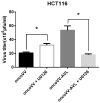Oncolytic Vaccinia Virus Expressing Aphrocallistes vastus Lectin as a Cancer Therapeutic Agent
- PMID: 31248066
- PMCID: PMC6628141
- DOI: 10.3390/md17060363
Oncolytic Vaccinia Virus Expressing Aphrocallistes vastus Lectin as a Cancer Therapeutic Agent
Abstract
Lectins display a variety of biological functions including insecticidal, antimicrobial, as well as antitumor activities. In this report, a gene encoding Aphrocallistes vastus lectin (AVL), a C-type lectin, was inserted into an oncolytic vaccinia virus vector (oncoVV) to form a recombinant virus oncoVV-AVL, which showed significant in vitro antiproliferative activity in a variety of cancer cell lines. Further investigations revealed that oncoVV-AVL replicated faster than oncoVV significantly in cancer cells. Intracellular signaling elements including NF-κB2, NIK, as well as ERK were determined to be altered by oncoVV-AVL. Virus replication upregulated by AVL was completely dependent on ERK activity. Furthermore, in vivo studies showed that oncoVV-AVL elicited significant antitumor effect in colorectal cancer and liver cancer mouse models. Our study might provide insights into a novel way of the utilization of marine lectin AVL in oncolytic viral therapies.
Keywords: Aphrocallistes vastus lectin; ERK; oncolytic vaccinia virus.
Conflict of interest statement
The authors declare no conflict of interest.
Figures






Similar articles
-
The employment of vaccinia virus for colorectal cancer treatment: A review of preclinical and clinical studies.Hum Vaccin Immunother. 2022 Nov 30;18(6):2143698. doi: 10.1080/21645515.2022.2143698. Epub 2022 Nov 11. Hum Vaccin Immunother. 2022. PMID: 36369829 Free PMC article. Review.
-
Oncolytic Vaccinia Virus Carrying Aphrocallistes vastus Lectin (oncoVV-AVL) Enhances Inflammatory Response in Hepatocellular Carcinoma Cells.Mar Drugs. 2022 Oct 26;20(11):667. doi: 10.3390/md20110667. Mar Drugs. 2022. PMID: 36354990 Free PMC article.
-
Oncolytic Vaccinia Virus Harboring Aphrocallistes vastus Lectin Inhibits the Growth of Hepatocellular Carcinoma Cells.Mar Drugs. 2022 Jun 4;20(6):378. doi: 10.3390/md20060378. Mar Drugs. 2022. PMID: 35736181 Free PMC article.
-
Oncolytic Vaccinia Virus Encoding Aphrocallistes vastus Lectin Suppresses the Proliferation of Gastric Cancer Cells.Hum Gene Ther. 2024 Nov;35(21-22):938-950. doi: 10.1089/hum.2024.100. Epub 2024 Oct 4. Hum Gene Ther. 2024. PMID: 39318235
-
Vaccinia virus, a promising new therapeutic agent for pancreatic cancer.Immunotherapy. 2015;7(12):1249-58. doi: 10.2217/imt.15.90. Epub 2015 Nov 23. Immunotherapy. 2015. PMID: 26595180 Free PMC article. Review.
Cited by
-
The employment of vaccinia virus for colorectal cancer treatment: A review of preclinical and clinical studies.Hum Vaccin Immunother. 2022 Nov 30;18(6):2143698. doi: 10.1080/21645515.2022.2143698. Epub 2022 Nov 11. Hum Vaccin Immunother. 2022. PMID: 36369829 Free PMC article. Review.
-
ROS Induced by Aphrocallistes vastus Lectin Enhance Oncolytic Vaccinia Virus Replication and Induce Apoptosis in Hepatocellular Carcinoma Cells.Mar Drugs. 2024 Jun 30;22(7):307. doi: 10.3390/md22070307. Mar Drugs. 2024. PMID: 39057416 Free PMC article.
-
A new strategy for treating colorectal cancer: Regulating the influence of intestinal flora and oncolytic virus on interferon.Mol Ther Oncolytics. 2023 Aug 24;30:254-274. doi: 10.1016/j.omto.2023.08.010. eCollection 2023 Sep 21. Mol Ther Oncolytics. 2023. PMID: 37701850 Free PMC article. Review.
-
AVL-armed oncolytic vaccinia virus promotes viral replication and boosts antitumor immunity via increasing ROS levels in pancreatic cancer.Mol Ther Oncol. 2024 Sep 17;32(4):200878. doi: 10.1016/j.omton.2024.200878. eCollection 2024 Dec 19. Mol Ther Oncol. 2024. PMID: 39431173 Free PMC article.
-
Marine Glycoconjugates: Trends and Perspectives.Mar Drugs. 2020 Feb 18;18(2):120. doi: 10.3390/md18020120. Mar Drugs. 2020. PMID: 32085418 Free PMC article.
References
MeSH terms
Substances
Grants and funding
LinkOut - more resources
Full Text Sources
Miscellaneous

